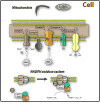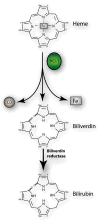Oxidants in Acute and Chronic Lung Disease
- PMID: 25705575
- PMCID: PMC4335304
- DOI: 10.4172/2165-7831.1000128
Oxidants in Acute and Chronic Lung Disease
Abstract
Oxidants play an important role in homeostatic function, but excessive oxidant generation has an adverse effect on health. The manipulation of Reactive Oxygen Species (ROS) can have a beneficial effect on various lung pathologies. However indiscriminate uses of anti-oxidant strategies have not demonstrated any consistent benefit and may be harmful. Here we propose that nuanced strategies are needed to modulate the oxidant system to obtain a beneficial result in the lung diseases such as Acute Lung Injury (ALI) and Chronic Obstructive Pulmonary Disease (COPD). We identify novel areas of lung oxidant responses that may yield fruitful therapies in the future.
Keywords: Acute lung injury; Chronic obstructive pulmonary disease; Oxidant stress; Oxidative phosphorylation; Reactive oxygen species.
Figures




Similar articles
-
Glucose-6-phosphate dehydrogenase inhibition attenuates acute lung injury through reduction in NADPH oxidase-derived reactive oxygen species.Clin Exp Immunol. 2018 Mar;191(3):279-287. doi: 10.1111/cei.13097. Epub 2018 Jan 21. Clin Exp Immunol. 2018. PMID: 29277898 Free PMC article.
-
Role of oxidants/antioxidants in smoking-induced lung diseases.Free Radic Biol Med. 1996;21(5):669-81. doi: 10.1016/0891-5849(96)00155-4. Free Radic Biol Med. 1996. PMID: 8891669 Review.
-
Oxidative stress, chromatin remodeling and gene transcription in inflammation and chronic lung diseases.J Biochem Mol Biol. 2003 Jan 31;36(1):95-109. doi: 10.5483/bmbrep.2003.36.1.095. J Biochem Mol Biol. 2003. PMID: 12542980 Review.
-
Diet and obstructive lung diseases.Epidemiol Rev. 2001;23(2):268-87. doi: 10.1093/oxfordjournals.epirev.a000806. Epidemiol Rev. 2001. PMID: 12192737 Review.
-
Antioxidant strategies in respiratory medicine.Treat Respir Med. 2006;5(1):47-78. doi: 10.2165/00151829-200605010-00004. Treat Respir Med. 2006. PMID: 16409015 Review.
Cited by
-
Karma of Cardiovascular Disease Risk Factors for Prevention and Management of Major Cardiovascular Events in the Context of Acute Exacerbations of Chronic Obstructive Pulmonary Disease.Front Cardiovasc Med. 2019 Jun 25;6:79. doi: 10.3389/fcvm.2019.00079. eCollection 2019. Front Cardiovasc Med. 2019. PMID: 31294030 Free PMC article. Review.
-
Short-term effects of particle gamma radiation activities on pulmonary function in COPD patients.Environ Res. 2019 Aug;175:221-227. doi: 10.1016/j.envres.2019.05.032. Epub 2019 May 21. Environ Res. 2019. PMID: 31146094 Free PMC article.
-
Prospective role of thyroid disorders in monitoring COVID-19 pandemic.Heliyon. 2020 Dec;6(12):e05712. doi: 10.1016/j.heliyon.2020.e05712. Epub 2020 Dec 13. Heliyon. 2020. PMID: 33344794 Free PMC article. Review.
-
Effects of sevoflurane preconditioning on lung injury during one lung ventilation.Int J Clin Exp Med. 2015 Aug 15;8(8):13634-8. eCollection 2015. Int J Clin Exp Med. 2015. PMID: 26550306 Free PMC article.
-
Induction of HO-1 by Mevastatin Mediated via a Nox/ROS-Dependent c-Src/PDGFRα/PI3K/Akt/Nrf2/ARE Cascade Suppresses TNF-α-Induced Lung Inflammation.J Clin Med. 2020 Jan 15;9(1):226. doi: 10.3390/jcm9010226. J Clin Med. 2020. PMID: 31952230 Free PMC article.
References
-
- Lane N. Oxygen: The Molecule that Made the World. USA: Oxford University Press; 2004.
-
- Fang YZ, Yang S, Wu G. Free radicals, antioxidants, and nutrition. Nutrition. 2002;18:872–879. - PubMed
-
- Patel RP, McAndrew J, Sellak H, White CR, Jo H, et al. Biological aspects of reactive nitrogen species. Biochem Biophys Acta-Bioenerg. 1999;1411:385–400. - PubMed
Grants and funding
LinkOut - more resources
Full Text Sources
Other Literature Sources
